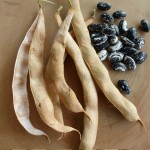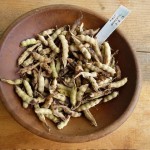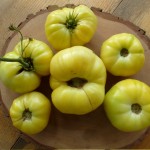Helping preserve our genetic diversity
By Sylvia Davatz
Now is a great time to think about what vegetable seeds you can save in your garden this season. Your own saved seed will have greater vigor and vitality, a better germination rate, and a longer life than purchased seed. Saving seed supports self-reliance and is deeply satisfying.

Chester Bean from Chester, Vermont
We’ve experienced a drastic consolidation in the seed industry in recent decades, along with an alarming loss of vegetable varieties, so your participation in the growing movement to preserve our priceless heritage of open-pollinated seeds is more needed and valuable than ever. Our current system of industrial agriculture is one or our greediest consumers of fossil fuel, so saving your own seed also saves energy even while you are helping build the very core of a local food supply.
Here are some basic guidelines for the beginning seed saver to help you get started. Be curious and adventurous, experiment, and read as much as you can to ensure you’ll do a good job in helping save pure seeds. Start with an easy crop and what you love to eat.

“Kefe Beinwil” Snow Pea (a Swiss landrace) pods drying
Be sure the seed you start with is of an open-pollinated variety, which will come true to type. Seed from hybrids will either be sterile or produce something completely different from what you started with. There are many wonderful small seed companies that specialize in open-pollinated seeds. Support them.
Saving seeds is all about preventing unwanted pollination or promoting it where it’s desired. Self-pollinating (or inbreeding) crops—examples: tomatoes, beans, peas, lettuce—are unlikely to cross with other varieties of the same species, so they are easy crops to start with. Cross-pollinating (or outbreeding) crops—examples: broccoli, carrots, onions, corn, squash, cucumbers—will cross with other varieties of the same species and would need to be isolated to keep the seed pure. Most out-breeders are pollinated by either wind or insects. There are several methods for isolating crops—distance, caging, hand-pollination, bagging— but the easiest is called time isolation, and it simply means that you grow only one variety of a given species per season.

White Delight Tomato
Here are some core issues you’ll need to pay attention to:
- Choose an annual to start with since these crops will flower and produce seed in one year. Biennials require two years to grow to seed, which means the plants need to be safely overwintered.
- Make sure your growing season is long enough. Many crops take longer to flower and produce mature seed than to grow to the eating stage.
- Even self-pollinated crops should be planted at least 10 feet from other crops of the same species to ensure seed purity. If you are growing a cross-pollinated crop such as squash or cucumber, plant only one variety a year unless you can observe minimum isolation distances.
- Have a sufficient plant population. The more plants you can harvest seed from, the greater the likelihood that you will be preserving the wide genetic pool that contains all the resilient characteristics of the variety. Examples: tomatoes, six plants. Squash or cucumbers, 20 plants. Corn, 200 plants. Self-pollinated varieties will need fewer plants than cross-pollinated ones, but more is always better.
- Know when to harvest the seed. Bean seeds should dry in the pod on the plant. Tomato seed is ripe when the fruit is ripe. Lettuce seed will ripen over many days and should be picked regularly. Some seed is ready when it comes off the plant. Other seed, like tomato, will benefit from fermentation since this can kill seed-borne diseases.
- Dry the seeds in a cool, well-ventilated spot, out of direct sunlight. Be sure seed is thoroughly dry before packing for storage. Keep clear and accurate records. Label seed with your source, year of harvest, any historical information.
- Share your seeds if you are sure they are true-to-type and viable. Do a germination test if necessary.
- Read, read, read. The best book to start with is Seed to Seed by Suzanne Ashworth.
- Enjoy the deep satisfaction of helping preserve our plants’ genetic diversity.
Sylvia Davatz has been saving seed for 20 years. She helped start the ‘Upper Valley Seed Savers Group’ and has served on the steering committee of the recently founded Grassroots Seed Network for the exchange of open-pollinated seed. You can reach her at sdav@valley.net








Leave a Reply